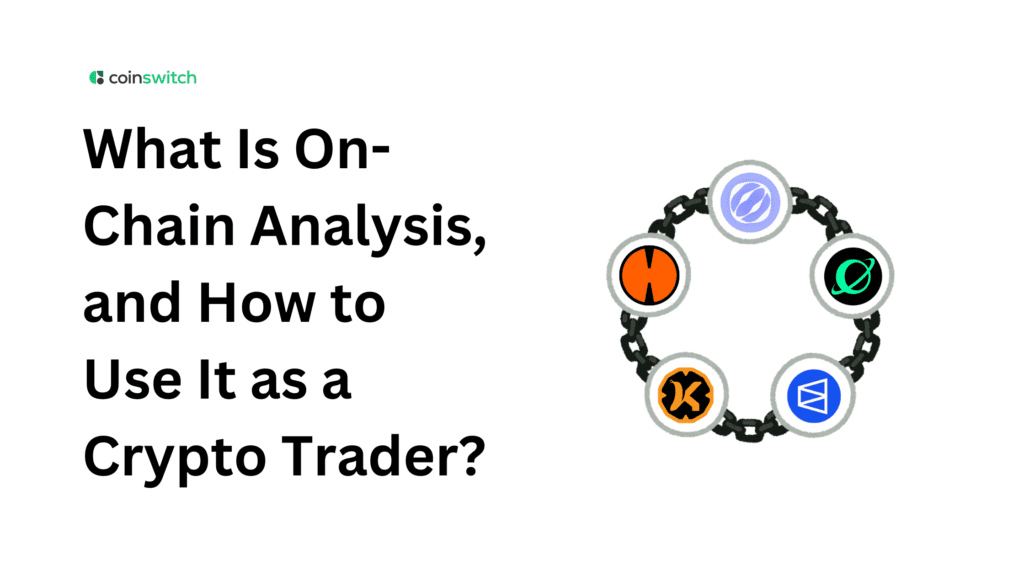Understanding On-Chain Analysis
Crypto is transparent by design. Every transaction, wallet movement, and token transfer lives forever on the blockchain. Anyone can see it, and that visibility is what gives birth to on-chain analysis.
On-chain analysis means studying blockchain data directly to gain insights into market trends, network health, and participant behavior. Instead of focusing only on charts and price patterns, traders dig into what’s happening inside the blockchain itself. Who’s buying, who’s selling, which wallets are accumulating, and where money is moving, it’s all visible if you know where to look.
On-chain metrics help decode behavior behind the price. When long-term holders start selling, it shows up on the chain before the price drops. When new wallets spike, it signals rising demand. Traders who master this art turn blockchain data into trading signals, spotting strength or weakness early.
On-Chain Data and Its Importance
On-chain data is raw information stored on a blockchain, including blocks, transactions, addresses, smart contracts, and token flows. But what makes it powerful is how you read it.
Imagine Bitcoin’s blockchain as a public accounting book. Every page shows who sent what to whom, how much they paid, and when. On-chain analysis turns that book into insight.
Read More: What are Hedging Contracts: An Explainer
Understanding Supply and Demand
Every coin moves for a reason. When supply leaves exchanges for cold wallets, it indicates that holders are storing long-term, which is a bullish signal. When coins rush back to exchanges, it usually means selling pressure is building. Tracking exchange inflows and outflows is one of the oldest and most reliable on-chain signals.
Tracking Whale Activity
Whales, wallets holding large amounts, move markets. On-chain analysis exposes their behavior in real time. If whales accumulate during dips, traders interpret it as confidence. If they start distributing while prices climb, it warns of profit-taking.
Measuring Network Health
Active addresses, transaction counts, and network fees all reflect blockchain vitality. When these rise with price, the market looks healthy. When price rises but activity drops, it suggests speculation rather than organic use.
Spotting Market Tops and Bottoms
Glassnode’s data shows that Bitcoin’s biggest rallies often start when long-term holders stop selling and short-term traders exit. By analyzing holder cohorts and unrealized profits, analysts can estimate where the cycle stands.
Read More: What Is Open Interest (OI) in Crypto Trading?
Tools for On-Chain Analysis
You don’t need to be a coder to read blockchain data anymore. A range of tools simplifies it, transforming raw transactions into clean dashboards and charts.
- Glassnode
A favorite among analysts, Glassnode offers advanced metrics on Bitcoin, Ethereum, and top altcoins. You can track exchange balances, realized profits, holder age distribution, and network momentum. It’s the go-to platform for visualizing trends backed by real blockchain data.
- Nansen
Nansen combines on-chain data with wallet labels. It tells you who is moving funds, insiders, retail clusters, or smart money wallets. Its dashboards highlight token inflows to centralized exchanges or new DeFi projects, giving traders early insights into capital flows.
- IntoTheBlock
Focused on accessibility, IntoTheBlock provides simple metrics like large transaction counts, concentration of whales, and holder profitability. It’s ideal for traders who want quick insights without diving too deep into code or API data.
- Dune Analytics
If you want customization, Dune lets you build customized dashboards using SQL queries. Analysts use it to track unique on-chain events, such as NFT trading activity, DeFi protocol TVL shifts, or new token distribution patterns.
- CryptoQuant
CryptoQuant shines with its exchange and miner data. It tracks how much Bitcoin miners sell, how much stablecoin liquidity moves between wallets, and which exchanges see heavy inflows. For short-term traders, that’s actionable information.
Read More: Understanding Leverage Trading in Crypto: A Simple Guide
On-Chain Analysis and Crypto Trading
On-chain analysis gives traders a unique edge. It focuses on behavior rather than price, helping you see the story before the market reacts.
Identifying Accumulation Phases
When long-term holders (wallets inactive for over six months) start adding coins, it often signals quiet accumulation before a rally. For instance, before Bitcoin’s 2020 bull run, on-chain data showed rising dormant supply, a clue that conviction was building beneath the surface.
Measuring Short-Term Trader Sentiment
Short-term holders sell quickly when volatility spikes. Monitoring their realized profits and losses helps measure emotional extremes. Heavy realized losses often mark panic bottoms.
Tracking Exchange Reserves
Exchange reserves act like a supply gauge. When reserves fall, it means coins move into storage, reducing the supply for traders. When reserves rise, potential sell pressure builds. Many short-term traders rely on this as an early indicator of trend shifts.
Watching Stablecoin Flows
Stablecoin movements tell you where money plans to go next. If USDT or USDC inflows hit exchanges, it signals buying intent. If they flow out, traders might be taking profits or moving to safety.
Spotting Smart Money
Through labeled wallets, on-chain tools reveal how funds and large investors behave. If multiple venture capital or whale wallets start acquiring a token, it often precedes a price breakout.
Timing Market Cycles
On-chain metrics like the MVRV ratio (Market Value to Realized Value) help traders assess overvaluation or undervaluation. When MVRV falls below 1, markets tend to be near bottoms. When it spikes above 3, euphoria dominates.
While chain analysis reveals fundamentals, technical indicators guide timing. Some professional traders combine both.
For example:
- On-chain data shows rising whale accumulation.
- Technical charts confirm a breakout above resistance.
- The trader enters confidently, knowing sentiment and price align.
This hybrid approach minimizes guesswork. The blockchain provides transparency, while technical patterns refine execution. Together, they create a complete picture of crypto market dynamics.
But remember, no tool is perfect. On-chain data has blind spots. That’s why on-chain data works best as confirmation. It supports decisions rather than dictating them. Smart traders use it like radar, a way to sense hidden movements while staying ready to adapt.
Conclusion
On-chain analysis turns the blockchain’s open ledger into a living map of sentiment, movement, and conviction. It helps traders read beyond charts and headlines, tracing how real capital behaves.
In a market driven by narratives, chain analysis offers hard data. It tells you when smart money moves, when retail panic sets in, and when confidence returns. For those willing to watch blockchain activity closely, the market stops being mysterious; it becomes measurable.
As more blockchains integrate analytics-friendly designs, on-chain data will keep evolving. Future traders might track not just wallets but specific behaviors, staking trends, protocol interactions, or even real-world asset flows tokenized on-chain.
For now, learning how to read the blockchain is one of the most valuable skills a trader can build. It’s insight straight from the source, no rumors, no delays, just truth in numbers.
FAQs
1. What is on-chain analysis in crypto?
On-chain analysis studies data recorded on a blockchain, transactions, wallet activity, and token flows to understand market behavior. Traders use it to gauge sentiment, track whales, and identify accumulation or distribution trends before they appear in prices.
2. What does on-chain mean?
“On-chain” means actions or records that happen directly on the blockchain and are publicly verifiable. Every transfer, swap, or smart-contract interaction that’s permanently stored on a network like Bitcoin or Ethereum is considered on-chain.
3. What is the On-Chain app used for?
The term “On-Chain app” usually refers to analytics platforms like Nansen, Glassnode, or CryptoQuant that visualize blockchain data. They help traders study capital flow, address activity, and token distribution in real time.
4. What are the three types of crypto analysis?
Crypto traders usually rely on three types of analysis:
1) Technical analysis, studying price charts and indicators.
2) Fundamental analysis, evaluating project value, team, and tokenomics.
3) On-chain analysis, reading blockchain data to track money flow and investor sentiment.
Together, they give traders a complete understanding of the crypto market.








